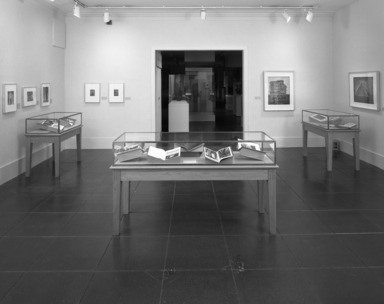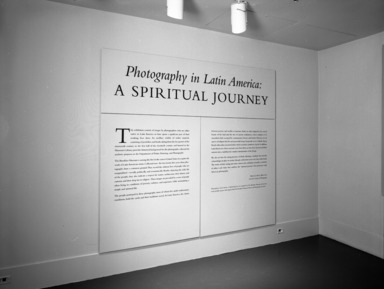

Latin American Photography: A Spiritual Journey, September 12, 1996 through January 19, 1997 (Image: PHO_E1996i107.jpg Brooklyn Museum photograph, 1996)
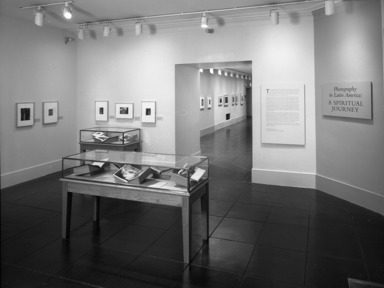
Latin American Photography: A Spiritual Journey, September 12, 1996 through January 19, 1997 (Image: PHO_E1996i108.jpg Brooklyn Museum photograph, 1996)
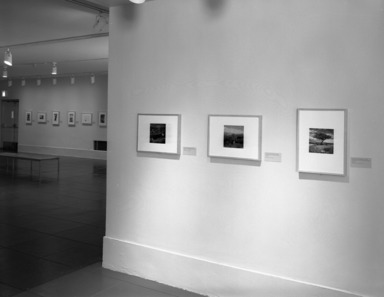
Latin American Photography: A Spiritual Journey, September 12, 1996 through January 19, 1997 (Image: PHO_E1996i109.jpg Brooklyn Museum photograph, 1996)

Latin American Photography: A Spiritual Journey, September 12, 1996 through January 19, 1997 (Image: PHO_E1996i110.jpg Brooklyn Museum photograph, 1996)

Latin American Photography: A Spiritual Journey, September 12, 1996 through January 19, 1997 (Image: PHO_E1996i111.jpg Brooklyn Museum photograph, 1996)

Latin American Photography: A Spiritual Journey, September 12, 1996 through January 19, 1997 (Image: PHO_E1996i112.jpg Brooklyn Museum photograph, 1996)

Latin American Photography: A Spiritual Journey, September 12, 1996 through January 19, 1997 (Image: PHO_E1996i113.jpg Brooklyn Museum photograph, 1996)

Latin American Photography: A Spiritual Journey, September 12, 1996 through January 19, 1997 (Image: PHO_E1996i114.jpg Brooklyn Museum photograph, 1996)
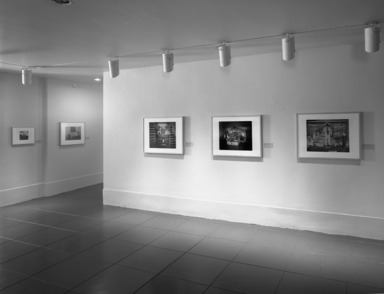
Latin American Photography: A Spiritual Journey, September 12, 1996 through January 19, 1997 (Image: PHO_E1996i115.jpg Brooklyn Museum photograph, 1996)
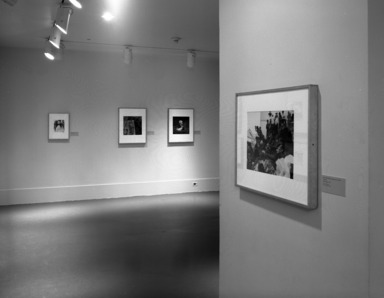
Latin American Photography: A Spiritual Journey, September 12, 1996 through January 19, 1997 (Image: PHO_E1996i116.jpg Brooklyn Museum photograph, 1996)
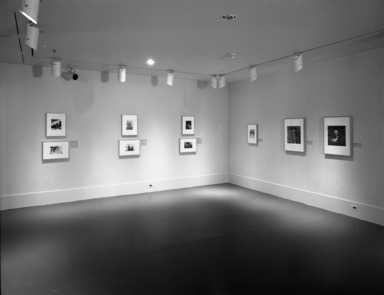
Latin American Photography: A Spiritual Journey, September 12, 1996 through January 19, 1997 (Image: PHO_E1996i117.jpg Brooklyn Museum photograph, 1996)
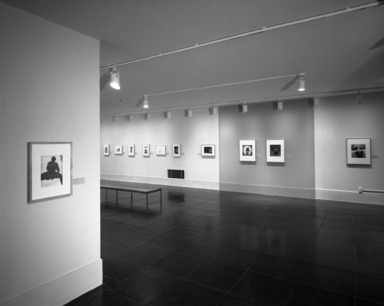
Latin American Photography: A Spiritual Journey, September 12, 1996 through January 19, 1997 (Image: PHO_E1996i118.jpg Brooklyn Museum photograph, 1996)
Latin American Photography: A Spiritual Journey
-
September 12, 1996
Photography in Latin America: A Spiritual Journey will include approximately seventy photographs by fifteen contemporary photographers who are native to Latin America, or have spent a significant part of their working lives there. Scheduled for October 25, 1996 through January 19,1997, the exhibition will include mostly black-and-white photographs with some color images. A small ancillary exhibition of earlier material, consisting of albums and single photographs dating from or referring to the 19th Century, will provide historical support to the exhibition.
All photographs are from the permanent collection of The Brooklyn Museum, and have been collected over the past twenty years. The exhibition will present the daily and spiritual life of the people of Latin America as seen through the eyes of such artists as Manuel Alvarez Bravo (Mexico), Graciela Iturbide (Mexico), Javier Silva Meinel (Peru), Flor de Maria Yanez Garduño (Mexico), Sebastiao Salgado (Brazil), Sebastian Rodriguez (Peru), and Valdir Cruz (Brazil). These artists, who are well known in Latin America and in the western United States, are infrequently shown on the east coast. Photography in Latin America: A Spiritual Journey will attract the attention of New York City’s large and diverse audience of photography enthusiasts, as well as New York’s large Latino audiences.
Photography in Latin America will continue The Brooklyn Museum’s history of exhibiting photography, which began in 1890. Early exhibitions featured artists who were to become the most famous in the history of the art form, including Berenice Abbott, Edward Weston, Walker Evans, and Edward Steichen. The Museum was one of the first museums in the eastern United States to seriously collect the work of the Latin American artists.
Most recently, the Museum’s tradition of recognizing great artists in this medium was continued with its retrospective of Lewis Wick Hine in 1977, which was chosen to be the first major exhibition of Western art shown in China after many years of prohibiting foreign culture. In 1993, the Museum presented an exhibition of photographs by Consuelo Kanaga (1894-1978), one of America’s most talented, albeit unrecognized, female photographers. The exhibition was praised in over fifty periodicals, including a full-page review in The New York Times.
The exhibition will address issues of social condition, historical imagery, landscape[,] and architecture. In this print by the photographer A. Briquet (a French portrait photographer who moved to Mexico in the first quarter of the Twentieth Century and finally assumed Mexican citizenship), we begin to understand the chasm between poverty and wealth. This image of two male peddlers dressed in rags (in all likelihood, father and son), bearing their respective loads of violins and bows, prompts us to wonder where the demand for their wares can possibly exist and who their customers might be. This early photograph reflects the tendency of contemporary photographers to explore ethnography and customs which were often, accidentally powerful and moving images. Landscape and architecture were also the subject of Latin American artists. In a work by the photographer, Renata Von Hanffstengel who was born in Germany in 1934 and has lived most of her life in Mexico, we are made acutely aware of the respect for architectural ruins that exist throughout Mexico and Latin America. In this arresting image titled Tecalic Space Open to the Divine, 1978, we can admire loving attention paid to the remains of this eighteenth century church (in the province of Tecal, Mexico). The grass kept trimmed beneath the roof of sky, flowers have been planted carefully at the column bases. It is in the aspect of religion that the most powerful imagery occurs in Latin America. Catholicism grounded, religious beliefs, [sic] blend with those of their ancestors, whose religions included numerous native and ancient gods.
Here in two examples by the Peruvian photographer, Javier Silva Meinel, Qollor Riti, Peru, 1993, and Lurin-Lima, 1993, we are made privy to two very different and striking ceremonies dealing with ancillary and ancient worship finally absorbed into Christianity. Qollor Riti, Peru is a ceremony of appeasement to the Gods of the ice glacier, mountain peaks of the North, while Lurin-Lima depicts an entreaty to the ocean gods of the Southern shores to make the fish bountiful. Both are considered Christian ceremonies but their roots lie in “Paganism”. However, the traditional stories of the new testament can be beautifully realized as in this marvelous image by the important Mexican photographer Lola Alvarez Bravo (pupil of her internationally recognized husband, the photographer Manual Alvarez Bravo). Here in her photograph, La Visitacion, Lola Bravo depicted the meeting of Mary and Martha when they have both learned of their respective pregnancies (Mary is carrying Jesus and Martha will bear John the Baptist)[. T]his photograph was made in 1934 just after Lola Bravo had left her husband to set out on her own career as a photographer.
Many Latin Americans also continue to accept beliefs that came from Africa with their ancestors who were slaves. The[re] is a strong presence of death reflecting a tradition which naturally accepts and acknowledges its place in society. Funerals are not an end to life, but rather a continuation of it, as is evidence[d] by the observance of Dia de Todos Muertos, in Mexico, in which picnics are held in the cemeteries once a year, and young lovers give each other skulls made of sugar often labeled with the word “Amor” or with their beloved’s name, as in this photograph by Manuel Alvarez Bravo of a young girl offering (or perhaps accepting) a sugar skull from her boyfriend.
Basteinne Schmidt, a young German photographer who travels frequently in Latin America and spent three years intensively photographing the culture of death in Columbia, Peru, Argentina, Ecuador[,] and Mexico, celebrates in her photographs several aspects of death including the predominant use of pre-adolescent children as maintainers of cemeteries in Latin America[,] and in her poignant image of Woman Mourning the Anniversary of the Death of Her Sister, she depicts the ceremony as a combination of renewal focusing on the kites that rise swiftly into the morning sky while the woman, restrained forcibly by her friends and relatives, gives full vent to her sorrow[.] She calls this series of images, “Vivir la Muerte, death ritual in South America.” Several of her photographs appear in this exhibition.
In Latin America and Mexico in particular, many small villages are occupied mainly by the elderly and women with children whose fathers have left to seek work in urban areas, inevitably starting new families and leaving their deserted wives to make a living in any way they can. In this remarkable photograph by Garciela Iturbide (Mexican, b. 1942), we see a Woman Carrying Sisal Fiber which is used in making mats and baskets. The material born[e] on her back gives her the appearance of an angel with wings of sisal. Her head crowned by a scarf turban and her body clothed in white fabric complete the illusion. Only her grim and determined expression gives us the clue to her burdensome existence as the total support of her family. Iturbide whose photographs are internationally admired has sought out these women as the subject of many of her most notable photographs including her famous Nuesta Senora de las Iguanas, which depicts a woman crowned by her lizards (which are sold to be eaten). The photograph Tropiero I (Cattle Driver, Parana, Brazil), 1990, printed 1991, is an especially powerful portrait of an eighty year old man who continues to make his living, driving cattle for hundreds of miles and many days while taking cattle to market. However, he is still handsome, vigorous[,] and unforgettable. The work is difficult but he does it willingly[,] according to the photographer, Valdir Cruz (Brazilian, b. 1954) who accompanied the Tropiero recently on a cattle drive. The subject matter of these photographs is neither violent nor political in nature. Rather, the photographs illuminate a view of spirituality and daily life which is unique to Latin American cultures.
The photographs will be organized geographically and by artist and will include both realist and conceptual artists. The prints will include both color and black and white and include several techniques ranging from early albumen prints to gelatin silver prints, color cibachromes[,] and color coupler prints.
The exhibition will also attempt to show the evolution in subject matter from the ethnological and travel photography of the nineteenth and early twentieth century to the present realist, artistic[,] and conceptual vision of contemporary photographers like Lourdes M. Grobet (Mexican, b. 1940) who attempted successfully to intervene in her landscape photography by actually painting the plants, trees[,] hills, and grasses before immortalizing them through her lens. There will also be work by the Brazilian photographer Mario Cravo Neto (b. 1947) whose depictions of Afro-Brazilians are truly and simply, magical, as in his Two Fish, Bahia, 1992, a masterwork of tone and texture. These are but a few examples of the more then seventy photographs in the exhibition.
Brooklyn Museum Archives. Records of the Department of Public Information. Press releases, 1995 - 2003. 01-06/1996, 049-53.
View Original

